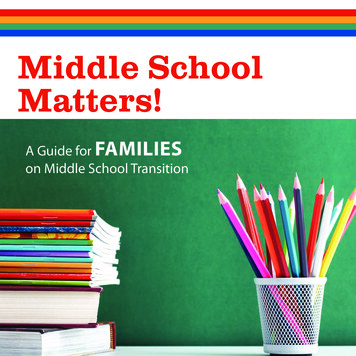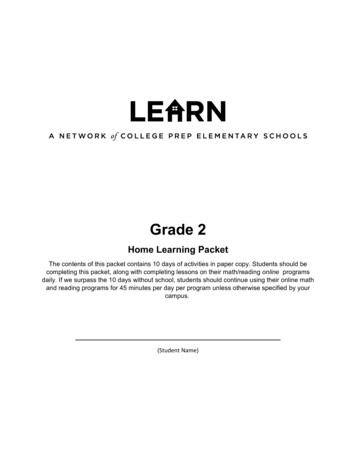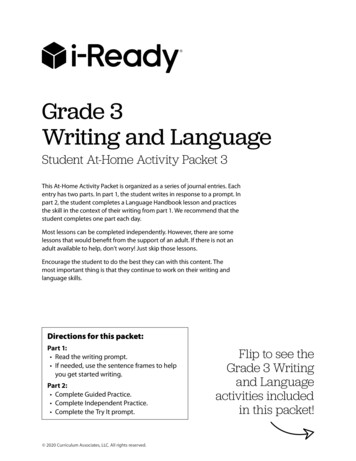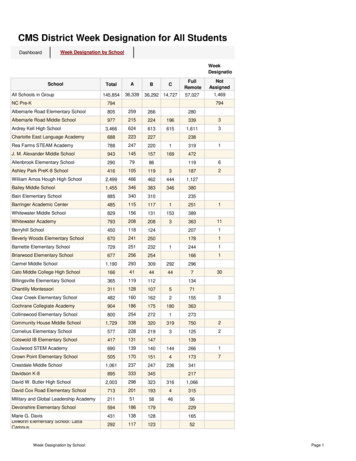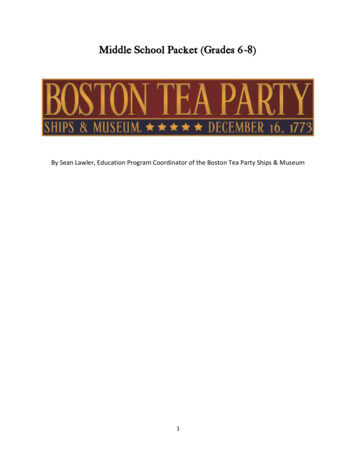
Transcription
Middle School Packet (Grade 6-8)By Sean Lawler, Education Program Coordinator of the Boston Tea Party Ships & Museum1
Table of Content “What i the Big Deal with Taxe ?” (Article) Pages 4-8Que tion for “What i the Big Deal with Taxe ?” Pages 9-11Glo ary Pages 12-15Bibliography Page 26Cla room Activitie The Bo ton Committee of Corre pondence Page 16The Loyal Nine Page 17-18Sugge ted Reading for the Di ciple of Liberty Pages 19-252
For Middle School Student (Grade 6-8)Have your students read the following article “What is the Big Deal with Taxes?” Once finished with thearticle, have your students answer the questions and fill in the timeline.3
“What i the Big Deal with Taxe ?”All of Boston was very happy. The French and Indian War ended in 1763. People in the colonies wereproud to be a part of the British Empire. King George III was a very popular man. People in Boston werehappy to be English and not French. In just two years, these good feelings would come to an end. Afterthe French and Indian War ended, King George still wanted to keep soldiers in Massachusetts in case theFrench and their Indian friends decided to invade again. Feeding the soldiers and supplying them with aplace to live was very expensive. So King George thought that people in the colonies should help pay forthe soldiers’ upkeep. To King George and Parliament, it was not unreasonable. Some people in thecolonies were happy to pay a tax for the soldiers. Others were angry that they were being taxed.Above: Coloni t were happy they won theFrench and Indian War. They were al o happythat King George III wa their ruler.Above: King George III.Left: The Briti h win the French and IndianWar with the help of American coloni t .4
The Taxe are Coming!Left: The Stamp Act wa pa ed inEngland. The new lowly made it wayacro the Atlantic Ocean to Bo ton alongwith the fir t tamp .Above: Coloni t prote t the StampAct by parading through the treet .Left: Stamp from theStamp Act of1765.Patriots protested King George III and his taxesin different ways. Some refused to buy or sellanything that came from England. Theyorganized a boycott against everything made byEnglish people. Other Patriots protestedillegally. They destroyed the homes and shopsof Loyalists, tarred and feathered tax collectors,and smuggled illegal things into Boston to avoidpaying taxes.In 1770, Parliament agreed to repeal all of thetaxes except the tax on tea. King George andParliament wanted to show the Patriots thatthey would not back down. King George feltthat he had the right to tax the colonies withouttheir consent. The Patriots demandedrepresentation in Parliament or else they wouldnot pay a single penny in taxes.5
The Bo ton Ma acre and the Town hend Act On the same day the Townshend Acts were repealed in England, redcoats in Boston were being pickedon by Patriots. Many of the Patriots were boys who were throwing snowballs at the soldiers. Some ofthe Patriots were men who threw large stones and wooden bats at the soldiers. This went on all day.Later that night, one of the wooden clubs hit a redcoat in the head, and as his musket fell from his handsand hit the ground, it fired off a shot. All of the other redcoats thought they could fire too. After thesmoked cleared, five Bostonians lay dead in the street. Paul Revere and Samuel Adams called this theBoston Massacre.Even after this terrible event, Parliament still wanted to punish the colonies. All of the Townshend Actswere repealed except for the tax on tea. Patriots continued to smuggle in tea illegally to avoid payingtaxes. It was only a matter of time before Parliament cracked down on their unlawful behavior.Left: Coloni t muggled teato avoid paying taxe . Herethey muggle in barrel underthe cover of night.Right: Paul Revere wa one ofthe Patriot leader whoencouraged coloni t to re i tParliament and King GeorgeIII.Above: The Bo ton Ma acre. The picture you see before you wa an engraving by PaulRevere. The ma acre made coloni t very up et that redcoat oldier were living in theirhome .6
The Bo ton Tea Party and the Start of the American RevolutionIn 1773, the East India Company was losing alot of money. King George and Parliamentwanted to help them out. They gave the EastIndia Company a monopoly on selling tea in thecolonies. This meant that only the East IndiaCompany could be sold in the colonies.Parliament selected seven loyal merchants tosell the tea. Patriot merchants were left out in thecold. Patriots would no longer be able to selltheir smuggled tea. This made them very angry.Colonists had to something about the 340 chestsof tea already on its way to Boston.Left: The Ea t IndiaCompany wa feared bycoloni t in Bo ton. Theyeven had their own armyto bully coloni t in India.The Ea t India Companyarmy i pictured left in thered uniform .Sam Adam (left) and Royal Governor Thoma Hutchin on (right) fought again t eachother on the i ue of taxation. Governor Hutchin on believed that Sam Adam and thePatriot had no right to prote t King George III and his law .7
Sam Adams and his Patriot friends agreed that they would not let the tea into Boston. This time thePatriots tried to send the tea back to England legally. Sam Adams spoke with the customs official RichardHarrison. Harrison demanded that the tea be unloaded and the taxes paid. The Patriots made one lastattempt on December 16, 1773 to send the tea back where it came from. Sam Adams sent Francis Rotchto talk to the Royal Governor Thomas Hutchinson.Thomas Hutchinson agreed with Richard Harrison. The tea would have to be brought into Boston, and thetaxes would have to be paid. His decision was final. Sam Adams called on the Sons of Liberty to goaboard the three ships at Griffin’s wharf and destroy the tea before it could be brought into Boston. TheSons of Liberty smeared burnt cork on their faces, stuck feathers in their caps, and wore blankets to keeptheir identities a secret. Once the tea was in the water, they vowed never to speak of the Boston Tea Partyagain.King George was very upset at Sam Adams and the Patriots for destroying the tea. After hearing about theBoston Tea Party, King George and Parliament passed the Intolerable Acts. Patriots were angry, so theystarted to collect guns to fight the British Army. When the British heard about this, they sent over 800soldiers to Concord, Massachusetts to take away all of the guns from the Patriots. The Patriots took astand against the redcoats in a small town called Lexington. The battle of Lexington-Concord was the firstbattle of American Revolution. Once the tea was thrown into Boston Harbor, it was clear to the Patriotsthere would be no turning back.Right: Colonel Franci Smith pictured here ledthe redcoat again t themilitiamen on LexingtonGreen.Above: Minutemen fight theredcoats at Lexington Green in thefir t battle of the AmericanRevolution.The Longe t March: In thi engraving by Amo Doolittle, redcoat are marching through Concordin the Battle of Lexington-Concord. Theredcoat had been marching all day and were verytired before the battle even tarted.8
Que tion for “What i the Big Deal with Taxe ?”7Directions: Use the article and the glossary of terms to answer the questions below.1. What is a boycott?A. The combined effort of a group of people who refuse to buy goods from a country orshop.B. When friends get together and drink a lot of soda.C. The combined effort of people to buy as many goods from a country or shop as they can.2. Why did King George III tax the colonies?A. He needed money for a video game.B. To pay for the British soldiers in the colonies.C. Because he wanted to buy ice cream.D. All of the above.3. Who are the Sons of Liberty?A. Patriots that were against King George III and all of his laws.B. Loyalists that supported the King and Parliament.C. Indians.D. All of the above.4. What is a monopoly?A. When a lot of businesses sell the same thing at the same time.B. When only one business is allowed to sell a good or service, and nobody else can.C. A cheeseburger with bacon and lots of ketchup.B True or Fal e BCircle true if the statement is correct, or false is the statement is wrong.1. Sam Adams was best friends with King George III.TrueFalse2. The Battle of Lexington-Concord was the first battle of the American Revolution.9
TrueFalse3. Patriots are people who are loyal to King George III and all of his laws.TrueFalse4. Patriots were angry because they would not be able to sell their smuggled tea once the EastIndia Company tea made it to Boston.TrueFalse5. To repeal an Act means that the Act has been cancelled, and colonists do not have to pay thetax.TrueFalse10
a Match the Act! aDirections: Draw a line from the Act on the left to the year it was passed and the goods that were taxedon the right.Passed in 1773, thisAct forced coloniststo drink the EastIndia Company tea.Townshend ActsThis made it illegalfor colonists tosettle west of theAppalachianMountains.Stamp ActPassed in 1767, thisAct taxed paint,lead, and glass.Tea ActPassed in 1765, thisAct taxednewspapers, playingProclamation of1763cards, and dice.11
Glo ary1. Boston Massacre: On March 5, 1770 British Regulars in Boston were attacked bypatriots that were throwing oysters, stones, and wooden bats. After hours of this, theBritish fired their muskets at them leaving five patriots dead.2. Boycott: The effort of a group of people to refuse to buy or sell goods from a shop orcountry. Patriots in Boston led a boycott against goods that were being taxed byParliament.3. British: People from England or any part of the world that was controlled by England.4. Colonist: A person who leaves their native country and settles in another land that is stillruled by the native country.5. Consignee: A loyalist merchant that was handpicked by Parliament to sell the tea.6. Customs Official: A person that was appointed by the crown to enforce rules and laws inBritish ports. These men would usually count the cargo aboard each ship once it arrivedin harbor and calculate how much the ship owner would have to pay the crown in taxes.7. Declaratory Act: A law passed by Parliament in 1766 right after the repeal of the StampAct. This Act announced that Parliament had the right to tax colonists without theirpermission whenever they pleased.8. East India Company: A company that traded goods from many different parts of theworld. In 1773, Parliament granted them a monopoly to sell tea in the colonies. Most ofthis tea had been expired for four years!9. French and Indian War: A war fought between the French and the British in NorthAmerica from 1754 to 1763. Both sides had Native American allies in the fight. The warhad cost so much money that Parliament thought the colonists should pay for some of it.10. Goods: Things that were bought and sold by merchants or shopkeepers. This is whatParliament wanted to tax.12
11. Government: A collection of people that rule a nation. In 1773, Parliament and KingGeorge III together were the government of the British Empire that ruled over the NorthAmerican colonies. On July 4, 1776 the Second Continental Congress adopted theDeclaration of Independence, making this the new government of the thirteen colonies.12. Intolerable Acts: In England these were called the Coercive Acts. They wereParliament’s response to the Boston Tea Party. The point of the Intolerable Acts was topunish Boston for the tea party.13. Liberty Affair: In 1768 customs officials tried to count the amount of cargo on JohnHancock’s ship the Liberty but were locked in a cabin below deck while Hancock’ssailors illegally brought the cargo into to town. The crown seized the Liberty and turned itinto a patrol boat because of this.14. Loyalist: A person who supports King George III, Parliament, and the laws they created.15. Massachusetts Charter: An agreement or pact between the King of England and thegoverning body in Massachusetts. The Massachusetts Charter allowed the colonists torule themselves since 1691.16. Merchant: A person who makes money by buying and selling goods. Merchants oftenowned fleets of ships and would buy goods in one place of the world, and sell them inanother place.17. Mohawk disguises: The Sons of Liberty loosely disguised themselves as MohawkIndians before they destroyed the tea in Boston Harbor. They stuck feathers in theirtricorn hats, smeared burnt cork on their faces, and wore blankets over their coats sonobody would recognize them.18. Monopoly: A business that controls the selling of a good or service. It could be illegalfor anyone else to sell the same good or service. The East India Company had amonopoly on tea.19. Navigation Acts: A series of laws passed by Parliament as early as 1651 that stated therules for trading across the high seas.20. Old South Meeting House: The largest public building in Boston. This is where Bostoncitizens met on December 16, 1773 to decide what should be done with the East India13
Company tea. Sam Adams, John Hancock, and Dr. Joseph Warren kept the meetinggoing while the Sons of Liberty threw the tea into Boston Harbor.21. Patriot: A person that was against King George III and Parliament, and questioned theirright to rule over the colonies.22. Parliament: A collection of men that made laws in England. They also made laws for thecolonists in America. Parliament still makes the laws in England today.23. Protest: An activity performed by a group of people that dislike or refuse to obey thewishes of someone.24. Repeal: To cancel or remove. When an Act was repealed, the colonists no longer had topay taxes for that Act.25. Representative: Person that is chosen to act based on the wishes of the people thatelected them. No colony in America had a single representative in Parliament.26. Royal Governor: Person that was put in place by the King to rule over Massachusetts.Thomas Hutchinson was the Royal Governor during the Boston Tea Party.27. Sons of Liberty: A group of Patriots in the colonies that protested against the authorityof King George III and Parliament.28. Smuggle: To bring a good in or out of a country illegally. Many merchants in Bostonsmuggled goods into the city without paying taxes. This was illegal.29. Stamp Act: A law passed by Parliament in 1765 which forced colonists to get theirpapers stamped. The Act taxed legal papers, playing cards, and dice.30. Stamp Act Riots: In August 1765, Bostonians that were angry over the passage of theStamp Act tore down the houses of British government workers. Stamp Master AndrewOliver, Lieutenant Governor Thomas Hutchinson, and William Story all lost their homes.31. Tax: Money that people in a country have to pay to support the King and Parliament.32. Tea Act: A law that was passed in 1773 that forced the colonists to pay a 3 penny tax onevery pound of tea. This Act gave a monopoly on the selling of tea in the colonies to theEast India Company. This meant that colonists were forced to buy the East IndiaCompany tea, they could not buy tea from anywhere else.14
33. Townshend Acts: Laws passed by Parliament in 1767 which taxed commonly usedgoods such as glass, paper, lead, paint, and tea. The tax was repealed on March 5, 1770,the same day as the Boston Massacre.34. Tyrant: A brutal person who rules their people unfairly. King George III was oftencalled a tyrant by Patriots and the Sons of Liberty.35. Wharf: A wooden dock along the shore where ships unload their cargo. In December1773, the three ships carrying the East India Company tea were tied up at Griffin’sWharf.15
For Student Grade 3-12The Bo ton Committee of Corre pondenceXIn an attempt to rally support for his cause, Samuel Adams proposed that Boston Patriots form acommittee of correspondence. On November 2, 1772 the Boston Committee of Correspondence wasestablished. While many textbooks make little mention of the committee’s activities, its role was crucialin resisting the laws of Parliament and King George III. The Boston Committee of Correspondence wroteletters to other colonies in British North America to keep them informed on the protest movement led bythe Sons of Liberty in Boston. One year later, New York, Philadelphia, and Boston used their committeesof correspondence to communicate with each other in deciding what they were going to do with the EastIndia Company tea.Directions: Create your own committee of correspondence! Choose one of the options below, and write aone or two paragraph letter to Paul Revere. Remember, it will take at least two weeks for this message toreach him overland. If the weather is bad and the roads are rocky it will take even longer! Address yourletters to Paul Revere at 306 Congress Street, Boston, MA 02210.1. Tell Paul Revere and the Sons of Liberty about your weekend. What did you do last weekend?Was it fun or interesting? What do you plan to do next weekend?2. Tell Paul Revere about what you are doing in class. Do you enjoy the subjects being covered?What subjects would you like to learn about next and why?16
For Student Grade 3-12The Loyal NineOThe Loyal Nine was a secret society that started meeting at Chase & Speakman’s Distillery next to theLiberty Tree as early as 1765. Their mission was to organize a protest movement in Boston against thelaws of Parliament and King George III. Members of the Loyal Nine were responsible for the Stamp ActRiots on August 14, 1765 and again on August 26, 1765. While many textbooks do not mention thisunderground organization, the Loyal Nine was the first group to openly defy Parliament and King GeorgeIII. In the coming years, the Loyal Nine would be responsible for forming the Sons of Liberty, the secretsociety that was responsible for destroying the tea on December 16, 1773. These secret societies laterbecame the foundation for democracy in America.Objective: Separate into groups of five and create your own secret society! Follow the steps below toturn your secret society into a powerful force for political change.1. Name your society.2. Give everyone in your society a title. For example: President, Chief, Chairman, Writer, VicePresident, Senator etc. (Someone should be chosen to write everything down).3. Choose one of the three topics below for your secret society to argue: Taxes are not fair. We should be represented in Parliament. We have a right to govern ourselves.4. Once you have picked one issue that everyone can agree on, your group should come up with fivereasons to back up the argument you have picked. Only spend one or two sentences per reason.17
5. Finally, list three ways or methods to go about making change happen. Some members of yourgroup might wish to start a revolution; others might want to negotiate with Parliament and KingGeorge III. Be creative! No answers are wrong; just make sure that everyone in your group agreeson the method!6. Present your secret society to your class. Tell them your name, the titles of people in your group,the issue you care most about, and how you plan to go about changing the world around you.Analyze your Secret Society’s SuccessInstructions: Working alone, in one or two paragraphs write a journal entry about whathappened when you met with your group. Did some of your classmates disagree with the issueyou picked or the method you chose to bring about change? How did you come to an agreement?Do you think meeting in a group and compromising with each other is the best way to change theworld around you?18
Sugge ted Reading for Di ciple of Liberty6These titles are suggested for students who have not yet learned about the Britishgovernment’s administration of North America, and the War of Independence which followed.They have been categorized as fiction and non-fiction. While the fictional books are great forsparking a student’s interest, they should be used in combination with the non-fictional workslisted below. In addition, parents and teachers should work with students to make sure theyknow the difference between historical fiction and non-fiction.D Fiction DI.Johnny TremainAuthor: Esther ForbesPublished: Houghton Mifflin Harcourt Publishing Company, 1943.Rating:ReviewThis fictional account of revolutionary Boston immerses students in the movement for independence.Johnny Tremain tells the story of the early revolutionary period through the eyes of a silversmith’sapprentice, Johnny Tremain. The story follows Tremain in his discovery of the independence movementthrough his work for a Whig newspaper, the Boston Observer. Here, he comes into contact withinfluential revolutionaries and decides to join the struggle for liberty. While this book was only looselybased in reality, its vivid account of colonial Boston goes unmatched. This book should be on everystudent’s summer reading list!Illustrations: NoII.The Boston Tea PartyAuthor: Rod EspinosaPublished:19
Rating:ReviewThis is an excellent novel for students who are just beginning to learn about the Boston Tea Party andthe War of Independence. This text chronicles the effects of the French and Indian War on colonialAmerica, the acts of taxation which sparked the protest movement in British North America, the BostonMassacre, and the Boston Tea Party. In addition, this book provides the reader with the viewpoints ofpatriots, as well as Tories (loyalists). The text coupled with the graphic illustrations gives students asnapshot of the period along with the personalities and perspectives of eighteenth century colonialAmerica. This book is great for students who have not yet studied the American Revolution, but is toosimple for advanced students.Illustrations: Yes.III. Why Don’t You Get a Horse, Sam Adams?Author: Jean FritzPublished: Penguin Putnam Books, 1974.Rating:ReviewJean Fritz has written many children’s books about the American Revolution, and this novel is perfect forthe novice reader. The story follows Samuel Adams and his dog Queue around Boston. The book paintsan accurate portrait of Samuel Adams and his perspective on the world in early revolutionary Boston.While this book is digestible for students 3rd grade and up, younger readers may require a readingpartner.Illustrations: Yes.x Non-fiction xI.The American Revolution Battles and LeadersEditor: Aaron R. Murray20
Published: D.K. Publishing Inc., 2004.Rating:ReviewThis book is wonderful for advanced readers, 5th Grade and up who wish to gain a better understandingof the American Revolution. Starting with the Battle of Concord in April 1775, this book takes its readersthrough the War of Independence ending with the Treaty of Paris signed on September 3, 1783. While itgives an account of the battles in the American Revolution, it does not cover the protest movement thatled up to the outbreak of war. I would recommend this book only to students who have previouslystudied this topic.Illustrations: Yes.II.The American Revolution for KidsAuthor: Janis HerbertPublished: Chicago Review Press Inc., 2002.Rating:ReviewThis book offers a number of features which make it ideal for students who are just starting to learnabout the War of Independence. For one, it contains a comprehensive timeline which details thefounding of Massachusetts Bay Colony, the protest movement against taxation without representation,culminating in the Boston Tea Party, and the outbreak of the American Revolution. In addition, this bookcontains twenty one activities to reinforce the text. The activities teach students about the principles ofdemocracy and the town meeting, and also explain the complicated inner workings of Congress. Thisbook is a great foundational piece because it covers the American Revolution, but also the earlystruggles the founding fathers faced in building an effective democracy.Illustrations: Yes.III.The Declaration of IndependenceAuthor: R. Conrad Stein21
Published: Cornerstones of FreedomRating:ReviewIdeal for students who would like a more thorough understanding of colonial America from 1754-1783,The Declaration of Independence offers everything from a detailed timeline, to a comprehensiveglossary of terms. In addition, this book covers the founding of British North America, the signing of theDeclaration of Independence in 1776, and everything in between. While this book is a great foundationfor young historians, it is probably best for students with a reading level of 6th grade and up.Illustrations: Yes (black and white).IV.The Boston Tea PartyAuthor: R. Conrad SteinPublished: Cornerstones of FreedomRating:ReviewThis is another book in the series on U.S. History that Cornerstones of Freedom has produced. This bookcovers the complicated political events which led to the destruction of the East India Company tea, andthe events that were precipitated by it. While it covers a period of history which is seldom covered intextbooks, it contains some embellished stories. Nonetheless, this book still makes the list as a goodsource for students grades 3-5.Illustrations: Yes.22
Sugge ted Reading for Advanced Reader 7All of the books on this list below are for advanced readers, and could easily be found on acollege syllabus. These sources are rated on their accuracy and ability to draw on primarysources to connect events with complicated political and economic trends in the British NorthAmerican colonies on the eve of the American Revolution.I.Defiance of the PatriotsAuthor: Benjamin L. CarpPublished: Yale University Press, 2009.Rating:ReviewThis book offers a wealth of knowledge on the colonists’ early struggles with the British government.Carp not only covers the Acts of taxation and the colonial protests, but also investigates the production,distribution, and consumption of tea. In addition, Carp uses a plethora of primary sources in order toplace Boston’s political struggles with Parliament within the scope of the Sons of Liberty’s resistance tothe Tea Act in New York and Philadelphia. Even still, he places the struggle of Boston’s patriots at thecenter of his analysis. While this book tackles complicated political, economic, and social issues, itpresents them in a manner which is both fascinating, and informative.II.As If an Enemy’s Country: The British Occupation of Bostonand the Origins of RevolutionAuthor: Richard ArcherPublished: Oxford University Press, 2010.23
Rating:ReviewAs the title suggests, Archer’s work focuses on mob violence committed by Boston patriots, the decisionof government officials to send regiments to occupy Boston, and the consequences which followed.While the scope of this book does not entail the Boston Tea Party, it still covers the era of politicalprotest which preceded the destruction of tea, and chronicles the occupation of Boston which inevitablyled to the Boston Massacre and the American Revolution. As If an Enemy’s Country offers a fascinatingtake on the Stamp Act Riots and Liberty Affair which persuaded Royal Governor Francis Bernard torequest troops for the occupation of Boston. Further, Archer uses primary sources to demonstrate theextensive public relations campaigns in which Samuel Adams and the Sons of Liberty engaged in todemonize the British regulars, and those royal officials who requested their presence in the first place.As If an Enemy’s Country does an excellent job of shedding light on material which is seldom covered inmost works on the American Revolution. For this reason, I would highly recommend this piece toanyone who would like to learn about the effects of the occupying British army during peacetime.III.Samuel Adams: A LifeAuthor: Ira StollPublished: Free Press, 2009.Rating:ReviewIra Stoll, a journalist by trade, sets out to shine light on the place of Samuel Adams within the context ofthe American Revolution. In this biography of one of Boston’s leading patriots, Stoll asserts that Adamswas deeply religious, and even went so far as to link his religious convictions with the political strugglesbetween Boston and the British government. While this book offers the reader a glimpse at the personaof Samuel Adams, it falls short of answering questions about his involvement in the protest movementwhich is still a highly debated topic.IV.John AdamsAuthor: David McCullough24
Published: Touchstone, 2002.Rating:ReviewJohn Adams by David McCullough masterfully pulls together the letters and correspondence of JohnAdams into a logical and cohesive narrative of his involvement in the Glorious Cause and later, in thefoundation of the republic. In between great events, McCullough paints Adams as a man who was filledwith insecurity and doubt. But these personal anxieties became the driving force behind his character,allowing him to fulfill his destiny as a founding father of the United States. This non-fictional account ofAdams’ life reads like a novel, but offers the reader a rare glimpse at the complex figure of John Adams,and his role as a founding father. This book is a must read!25
Bibliography1. Carp, Benjamin L. Defiance of the Patriots: The Boston Tea Party & the Making of America. YaleUniversity Press, 2010.2. Ghere, David L., Spreeman, Jan F. Causes of the American Revolution: A Unit Study for Grades 712. Organization of American Historians and the National Center for History in the Schools,University of California, 2007.3. Lukes, Bonnie L. The Boston Massacre. Lucent Books, New York, 1998.4. McCullough, David. John Adams. Simon & Schuster, New York, 2001.5. Stoll, Ira. Samuel Adams: A Life. Free Press, New York, 2008.6. Wood, Gordon S. The American Revolution: A History. The Modern Library, New York, 2012.26
Patriots tried to send the tea back to England legally. Sam Adams spoke with the customs official Richard Harrison. Harrison demanded that the tea be unloaded and the taxes paid. The Patriots made one last attempt on December 16, 1773 to send the tea back where it came from. Sam Adams se



